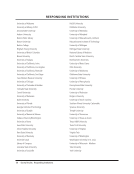188 · Representative Documents: Managing Digital Assets
WASHINGTON UNIVERSITY IN ST. LOUIS
Digital Project Support Framework
http://digital.wustl.edu/create/Digital_Project_Framework_Rev_L.doc
determine how schools, the library, or the University will allocate these resources, since
such decisions should be made by the school, library, or university itself.
• Class 1 – Local Project. No significant support from either the school or library.
The project is completely controlled and developed by the local faculty or student
groups. Funding may be from a department or external agency. Operation time
length is up to the faculty or students.
• Class 2 –School Supported Project. Similar to Class 1 projects except there is
significant support by the school. School supported projects will normally be
required to meet standards set by the school.
• Class 3 –University Supported Project. Similar to Class 1 and 2 projects
except there is significant support by the University (via the library and possibly
the school). University supported projects will normally be required to meet
standard set by the library and/or school.
6.2.2 Content Approach (Project Standards)
A project’s content approach refers to whether a project implements standards that
allow for data migration and preservation. Content approach can fall into three
categories:
• Type 1—Local Use Only. In this content approach, data is created with no
intention of having it preserved for the long-term or migrated to any third-party
system, such as the University Digital Library or the Digital Asset Repository.
• Type 2 – Storage in Digital Asset Repository. Directors of a project using this
approach would incorporate the minimal metadata and formatting requirements to
enable the library to store their data in the Digital Asset Repository. The library
would not be required to provide user-friendly interfaces, search functions, etc.
for such data.
• Type 3 –Inclusion in the University Digital Library. The most labor-intensive
content approach, this method incorporates enough metadata and otherwise
responds to library requirements for ingestion into the Digital Library. The
Digital Library provides at least a minimal infrastructure for retrieving data.
Please note that meeting these standards does not guarantee ingestion into the
Digital Library it is simply a minimal requirement for acceptance.
Not all the content of a given project may fall into a single category. Some content
may be generated at library archival standards for inclusion into the University Digital
Library or Digital Asset Repository while other content may be generated just for use in
the local project. Further, a Class 1, Class 2, or Class 3 project (as defined in §6.2.1) may
be developed by a project team who plans to operate it for only a few years, but who
hopes that the content will be curated for the long term. Thus, content for even a local
project may be generated to meet library standards for future inclusion into the University
digital
6.2.3 Presentation Approach
WASHINGTON UNIVERSITY IN ST. LOUIS
Digital Project Support Framework
http://digital.wustl.edu/create/Digital_Project_Framework_Rev_L.doc
determine how schools, the library, or the University will allocate these resources, since
such decisions should be made by the school, library, or university itself.
• Class 1 – Local Project. No significant support from either the school or library.
The project is completely controlled and developed by the local faculty or student
groups. Funding may be from a department or external agency. Operation time
length is up to the faculty or students.
• Class 2 –School Supported Project. Similar to Class 1 projects except there is
significant support by the school. School supported projects will normally be
required to meet standards set by the school.
• Class 3 –University Supported Project. Similar to Class 1 and 2 projects
except there is significant support by the University (via the library and possibly
the school). University supported projects will normally be required to meet
standard set by the library and/or school.
6.2.2 Content Approach (Project Standards)
A project’s content approach refers to whether a project implements standards that
allow for data migration and preservation. Content approach can fall into three
categories:
• Type 1—Local Use Only. In this content approach, data is created with no
intention of having it preserved for the long-term or migrated to any third-party
system, such as the University Digital Library or the Digital Asset Repository.
• Type 2 – Storage in Digital Asset Repository. Directors of a project using this
approach would incorporate the minimal metadata and formatting requirements to
enable the library to store their data in the Digital Asset Repository. The library
would not be required to provide user-friendly interfaces, search functions, etc.
for such data.
• Type 3 –Inclusion in the University Digital Library. The most labor-intensive
content approach, this method incorporates enough metadata and otherwise
responds to library requirements for ingestion into the Digital Library. The
Digital Library provides at least a minimal infrastructure for retrieving data.
Please note that meeting these standards does not guarantee ingestion into the
Digital Library it is simply a minimal requirement for acceptance.
Not all the content of a given project may fall into a single category. Some content
may be generated at library archival standards for inclusion into the University Digital
Library or Digital Asset Repository while other content may be generated just for use in
the local project. Further, a Class 1, Class 2, or Class 3 project (as defined in §6.2.1) may
be developed by a project team who plans to operate it for only a few years, but who
hopes that the content will be curated for the long term. Thus, content for even a local
project may be generated to meet library standards for future inclusion into the University
digital
6.2.3 Presentation Approach


































































































































































































